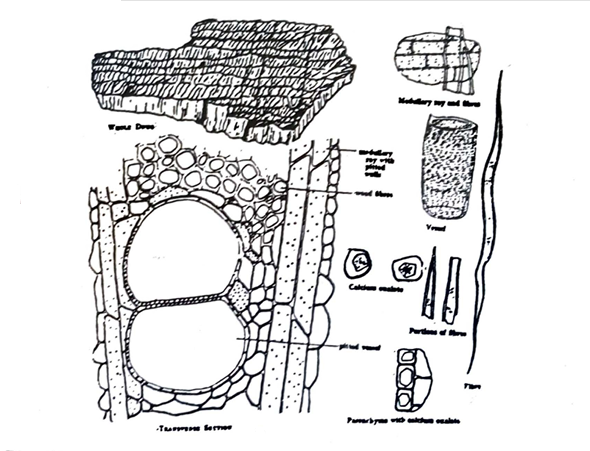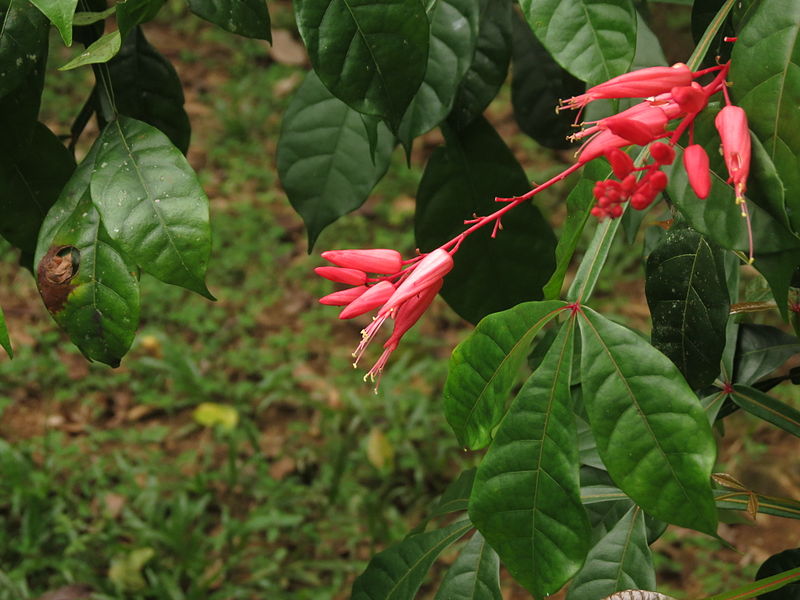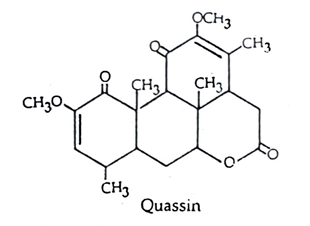Synonym
Quassia Wood, Quassia Lignum, Jamaka Quassia
Botanical source
Quassia is the stem wood of Acraena excelsa (Sw.) Lindl. (Picrasma excelsa or Aeschrion excelsa), the Jofty bitter wood tree of the family Simarubaceae. It is known in commerce as Jamaica Quassia.
Quassia Geographical Source
The 15 to 30 metre high Quassia wood tree grows in the West Indian Islands and the wood is exported from Jamaica.
 Fig. 53: Quassia. A, Whole drug; B, transverse section through vessels; C, cellular structures of powdered drug (Reconstructed from Hebert & Ellery).
Fig. 53: Quassia. A, Whole drug; B, transverse section through vessels; C, cellular structures of powdered drug (Reconstructed from Hebert & Ellery).
Macroscopical Characters
The wood occurs in logs, raspings, chips or shavings of variable sizes, yellowish white or bright yellow in colour and has a short fracture and a specific gravity of 0.54 to 0.56. Numerous-medullary rays appear as white radial lines on the fractured surface. The outer surface exhibits a fragmented wood structure with occasional patches of bark. The arrangement of the xylem parenchyma in tangential bands gives an appearance resembling annual rings. Chips break readily into smaller fragments. The wood possesses an intensely bitter taste but no odour.

Image source: wikipedia.org
Microscopical Characters
Medullary rays of one to five cells wide and ten to fifteen cells high occur crossing the fibres at right angles. individual cells are radially elongated with pitted walls and occasionally contain prisms of calcium oxalate and starch grains. Wood fibres are long and tapering with moderately thickened and obliquely pitted walls, Vessels usually occur m groups of two or three arranged parallely to the medullary rays, moderately thick walled with numerous oval bordered pits. Wood parenchyrna consists of axially elongated cells with moderately thick, pitted walls and occurs in concentric bands. Large single prisms of ~alciurn oxalate and very occasional starch grains are present.
Chemical Constituents
Quassia contains the bitter amaroids quassin, isoquassin and neoquassin. It also contains a small quantity of a yellow crystalline substance.

Uses of Quassia
Quassia is medicinally used as a bitter tonic and is given as an enema for expelling threadworms. It is also used as an insecticide.
Substitute
Surinam Quassia from Quassia amara is used as a substitute for Quassia and exhausted Quassia is frequently admixed with the drug.

A little confused. I have identified the pic Rae a excelsa. When boiling water is poured over leaves green or dried the tea turns blood red. Do I have the right thing? It is identical as pictured with those red flowers. Curious to know please